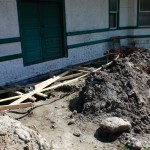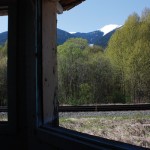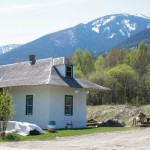By: Frank Green
The restoration of Dunster’s old train station will be finished by August 1st, in time for the celebration of the community’s centennial.
It’s a rebirth about thirty years in the making—the building was almost lost in the 1980s when the Canadian National Railway was demolishing old stations they’d stopped using. Dunster’s station had been a pillar of the community, along with the school and the general store. Villagers gathered there for mail and gossip and deliveries. But they turned to cars when the Yellowhead Highway arrived in Dunster. The station got decommissioned, and it was destined for the dump.
But locals intervened. They bought it from CN for a $1 and relocated it just down the hill from the train tracks, across from the Dunster General Store.
In saving a piece of history, they also saved the community from a sprinkling of lead and asbestos. Jill Howard, who’s spearheading the restoration, had to call in a hazmat team from Prince George before she could get started on a fresh paint job.
The project is a huge undertaking. It’s expected to cost over $90,000, including $20,000 worth of cash and in-kind donations—and Howard has applied for grants to pay for the rest. But until she gets it, she’s paying for some things out-of-pocket.
“Sometimes you gotta take a chance,” said Howard, who’s taught science and math, and worked on environmental stewardship projects. “You know it’s good. You know it’s important. There’re some things, if you turn your back they’re gone.”
Donations are pouring in. Pete Amyoony is contributing heritage lilacs, so the station’s garden will bloom the way it did in the early 20th century. Archie Maclean is designing the ramp to make the building accessible to people in wheelchairs. A velocipede—an old-time contraption, sort of like a bicycle, that’s designed to ride on train rails—is on the way from Prince George. The Ministry of Transportation is donating gravel, and Lakes District Maintenance is donating the trucking time to deliver it.
The old station is also going to have a museum, complete with a room replicating what the station looked like in the early 20th century, when different agents cycled through, living there with their families. Heather Zahn is working to bring that to life, and she encourages anyone with artifacts from station from the 1910s, ‘20s, or ‘30s to bring them by.






